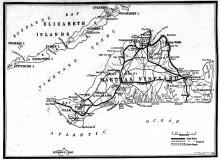The runic rock of Noman’s Land was discovered and identified beyond doubt by the weekend expedition led by Curtiss Bacon, lawyer and visitor to the Vineyard, who has interested himself in an attempt to subject the runes to more complete study than has yet been made. The rock had not been seen since the 1938 hurricane when a great section of cliff on the western shore of Noman’s Land fell into the sea, and it may have been covered for years by this fallen material.
Conditions were such that the weekend investigators could not establish the state of the runes, carved characters observed long ago and variously regarded as probable relics of the Norse voyages, as a hoax, or as a modern attempt to memorialize the Norsemen. Mr. Bacon said that the rising tide prevented a careful examination, but that some moss and lichen was scraped away without definite disclosure of any runes. To what extent the carved characters may have been worn away by sea and sand remains to be established.
Mr. Bacon said that his next step will be to attempt to interest the Navy, which now owns Noman’s Land, in removing the rock to the mainland for study, and presumably for eventual preservation in a museum.
The Next Step
Mr. Bacon and his group went to Noman’s Land, by permission of the Navy, in Donald W. Vose’s cruiser. Capt. Donald Poole of Menemsha went in his boat and pointed out the general area where the rock had been known to be. With Mr. and Mrs. Vose and Mr. Bacon were Mr. and Mrs. Graham White, William Nerney of East Chop and Attleboro, who took part in the Pohl studies at Bass River; Walter Olsen, an experienced geologist; Mark Donahue of New Jersey, George Zabka, photographer; and Diane and Warren Vose.
Mr. Bacon and Mr. Zabka had previously flown over Noman’s Land and from the air had spotted Whale Rock, from which the bearing of the runic rock was known from photographs. Although the accuracy of this observation could not then be certain, it was later confirmed.
In the Same Position
The runic rock was found in the same position as shown in old photographs. Mr. Bacon estimates its size as about forty-five cubic feet, the length 4 feet, and depth 3 1/2 feet.
Noman’s Land, the visitors found, has been little changed by the target bombing of the Navy. There are, it is reported, only three or four target areas on the island, and the practice bombs used are so light that no scars of any significance are left on the ground. Navy observers have been on the island during bombing, to make observations.
But old paths have grown up so that they are hardly traversable any more, and the buildings that once stood on Noman’s have fallen into ruin, most of them no marked only by their foundations.
Editorial: Runes and Research
Another expedition to Noman’s land in the hope of finding the rock, formerly lying in the tide wash, on which certain runic symbols were carved, indicates the persistence with which Norse traces have been sought on and about the Vineyard over a long period of years. The runic rock of Noman’s Land has not been seen since the hurricane of 1944, but it may be found again, perhaps tilted, perhaps settled into the sands, for further study.
Long ago Ole Bull, the self-taught Norwegian violinist, musician and showman, came to the Vineyard because he had heard there ‘were runes on Lover’s Rock at the Oak Bluffs beach. Alas, Lover’s Rock could not be turned over to see what might be on the under side! Within a few years another researcher hoped to get a look, but as the rock is now placed its turning would be a complicated and costly adventure.
Then there is the Cromlech of Quitsa, a combination of rocks which impresses everyone who sees it, especially those who have traveled abroad and seen the cromlechs and dolmans of Scandinavia—except that one old timer said it was arranged to contain ice. No less convenient or sensible ice house could be imagined. All in all, the so-called cromlech comes closest to visual proof that the Vikings came to .this Island long ago.
Then there is one more trail, unfortunately lost. An inscription observed on a rock at North Tisbury, copied and submitted to scholars, proved to be runic. But the rock has never been found save by the workman who happened across it and made the copy of the runes almost a generation back.
Such are the tantalizing fragments that continue to beckon enthusiastic researchers on.













Comments